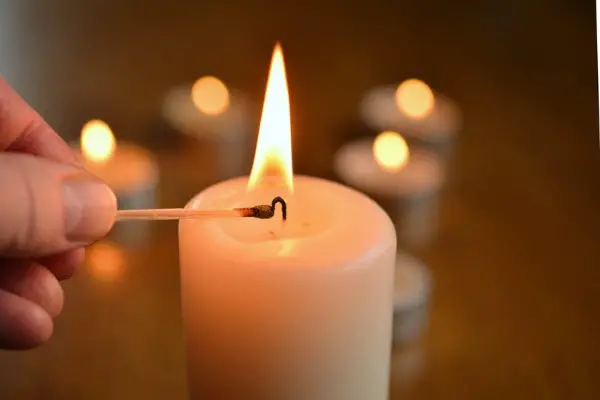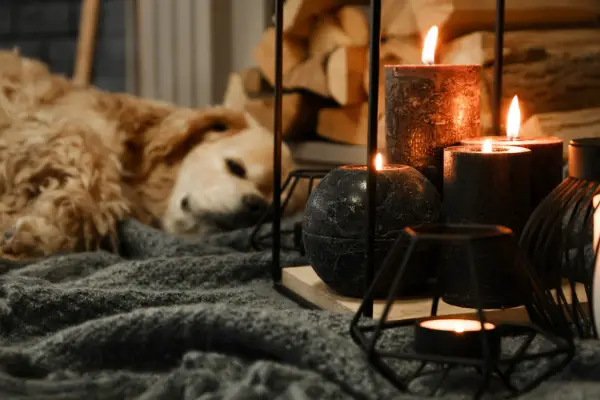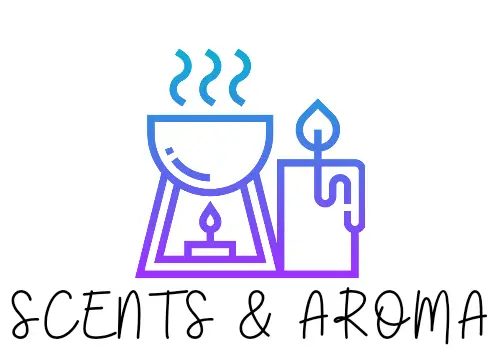We are often told about never leaving a candle burning unattended, but many people often wonder whether we can leave candles to burn out by themselves and even whether they can do this or not.
While we agree that you should never leave a candle unattended, we still want to know do candles burn out on their own? If you decide to leave a candle burning, it will eventually burn itself out. However, if your candle has a wick with metal on the bottom, as is common with container candles, you shouldn’t let it burn out on its own. Allowing this can cause the glass or jar container to crack which may allow the wick to cause a fire.
Will a candle put itself out?

Candles that will put themselves out have a self-extinguishing wick. This is usually a metal tab that has a ‘neck’. Unfortunately, it’s often impossible to know the type of wick used unless you have made the candle yourself. This means that you won’t know for sure if the flame will put itself out and, thus, will be taking a gamble when you leave it burning.
Candles contained within a glass jar are more risky to leave burning. This is because if the heat reaches the bottom, it could make the candle glass crack or explode. If this happens, the wax could flow out of the candle, and the flame or wick could cause a fire.
For this reason, it is also essential to put your candle on a non-flammable and heat-resistant surface – even if it is in a glass container or jar.
A heat-resistant surface is one that doesn’t heat up quickly or burns easily.
Some examples of surfaces include your stovetop, kitchen counter (e.g. granite stone counters), your dining room table, or other wooden surfaces that have been treated to be fire-resistant.
You might be surprised to learn that wood is actually heat-resistant! Lots of dining tables, bedroom furniture (like dressers and bedside tables), living room furniture (coffee tables, side tables etc.) are made of wood that has been treated to be fire-resistant.
It’s also possible to find candle plates or holders to protect surfaces. These are usually made from heat-resistant metal or glass and can be found in department stores or home décor stores.
What happens if you leave a candle burning overnight?
First of all, it is never ok to leave a candle burning when you are asleep – no matter the time of day. There are lots of associated risks with leaving a candle unsupervised, many of which could cause irreversible damage.
Let’s look at some of the risks of leaving a candle burning overnight.
1. The candle might be knocked over
Even if you live alone, this is possible. For example, a pet, wind, or a blowing curtain could knock it over. And if this happens, the potential for damage is huge – and you wouldn’t even know until the problem was a big one.

2. The glass could break
If your candle is in a glass container or jar, then leaving a candle burning overnight could cause the jar or container to break.
The glass will break when temperatures get high enough. So, if you burn a candle too long or it burns to the bottom of the jar, it might end up burning so hot that the glass breaks. If this happens, the jar might burst and release the flames, causing a huge hazard.
3. Leaking wax
If a glass jar or container breaks, damage can also be caused by hot, molten wax burning surfaces or damaging them.
4. Secondary ignition
Secondary ignition means that something falls into the candle container or jar. This could cause a fire which can spread to other areas. Things like plants or curtains, for example, are especially problematic.
5. Flashover
A candle flashover is when some of the melted wax sets alight. This cause a tiny flutter of fire lasting a few seconds. If your candle is burning overnight and is unsupervised, this could cause a fire because no one will be around to stop it from taking hold and spreading.
6. Candle toxicity
Certain types of candle wax – especially paraffin – release toxic chemicals and harmful substances like carcinogens into the air when they burn. Burning these candles causes an accumulation of indoor air pollution when they burn in an enclosed space or room for a long time. If this occurs in your bedroom while you’re sleeping, you will be breathing in these harmful substances overnight. If you leave the candle burning overnight in another room, walking into that room in the morning could also be harmful as you will have a sudden exposure, which will be uncomfortable.
Can a candle in a glass jar cause a fire?
Glass jar and container candles are increasingly popular these days. However, it is possible for glass to break or crack. This is more likely when heat is concentrated on a particular area. So firstly, you can’t just use any glass, it’s best to check that the glass is heat-resistant. Even if it is, it could still break.
Glass candle containers can break if the candle wick has been placed too close to one side of the container or if the flame is allowed to burn too close to the container bottom.
Like any candle, you should still take precautions when burning a jar candle and should still protect the surface with a heat-resistant mat or plate.
If you notice that the wick isn’t central, stop burning the candle immediately and throw it away. Equally, if you see the flame is getting close to the bottom of the jar, you should extinguish the candle.
This is because too much concentrated heat at the wick’s base can cause cracking. Good container candles typically have a self-extinguishing wick that has a higher neck, but you won’t know until the candle burns itself out, so it’s not worth the risk.
Is it safe to leave a candle burning unattended?
Unattended candles are responsible for starting many preventable fires.
Unfortunately, they have also been responsible for causing deaths. Often, things like paper or candles have been left too close to the candle, which causes them to ignite and spread the fire.
If you burn candles, you should make sure you do it safely. This includes putting a candle out before you leave a room, ensuring there are no flammable substances nearby, using safety plates underneath, keeping pets and children away, and not allowing children or teens to burn candles without you there.
Final thoughts – do candles burn out on their own?
While candles do burn out on their own, it’s never a good idea to let them – even if they have a self-extinguishing wick.
It’s simply not worth the risk of causing a fire by leaving a candle to burn out. In addition, a candle can cause a glass jar to break if the flame gets too low in the container and concentrates the heat onto the bottom. What’s more, you should always be in the room when a candle is burning – and be awake too!
- Can You Put Perfume In A Humidifier? (Read First) - September 17, 2022
- Can You Put Essential Oil In A Steam Mop? (Safety Advice) - September 17, 2022
- How To Make Lavender Oil At Home ( Candles And Diffusers) - September 9, 2022

